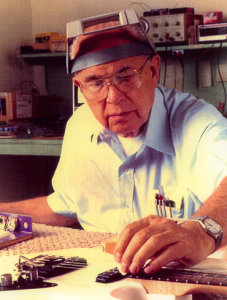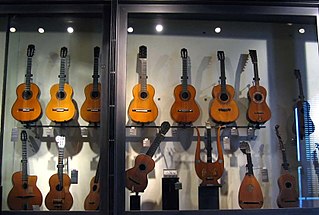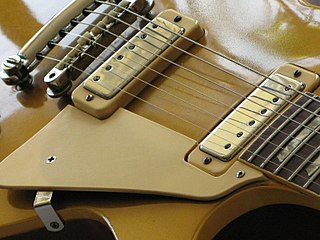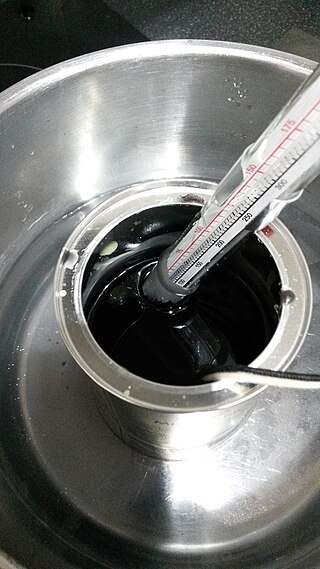Related Research Articles

The bass guitar, electric bass or simply bass is the lowest-pitched member of the guitar family. It is a plucked string instrument similar in appearance and construction to an electric or acoustic guitar, but with a longer neck and scale length. The bass guitar most commonly has four strings, though five- and six-stringed models are also relatively popular, and bass guitars with even more strings or courses have been built. Since the mid-1950s, the bass guitar has largely come to replace the double bass in popular music due to its lighter weight, the inclusion of frets in most models, and, most importantly, its design for electric amplification. This is also because the double bass is acoustically compromised for its range in that it is scaled down from the optimal size that would be appropriate for those low notes.

An electric guitar is a guitar that requires external electric sound amplification in order to be heard at typical performance volumes, unlike a standard acoustic guitar. It uses one or more pickups to convert the vibration of its strings into electrical signals, which ultimately are reproduced as sound by loudspeakers. The sound is sometimes shaped or electronically altered to achieve different timbres or tonal qualities via amplifier settings or knobs on the guitar. Often, this is done through the use of effects such as reverb, distortion and "overdrive"; the latter is considered to be a key element of electric blues guitar music and jazz, rock and heavy metal guitar playing. Designs also exist combining attributes of electric and acoustic guitars: the semi-acoustic and acoustic-electric guitars.

The guitar is a stringed musical instrument that is usually fretted and typically has six or twelve strings. It is usually held flat against the player's body and played by strumming or plucking the strings with the dominant hand, while simultaneously pressing selected strings against frets with the fingers of the opposite hand. A guitar pick may also be used to strike the strings. The sound of the guitar is projected either acoustically, by means of a resonant hollow chamber on the guitar, or amplified by an electronic pickup and an amplifier.

A humbucker, humbucking pickup, or double coil, is a guitar pickup that uses two wire coils to cancel out noisy interference from coil pickups. Humbucking coils are also used in dynamic microphones to cancel electromagnetic hum. Humbuckers are one of two main types of guitar pickups. The other is single coil.

Clarence Leonidas Fender was an American inventor and founder of the Fender Musical Instruments Corporation.

A single-coil pickup is a type of magnetic transducer, or pickup, for the electric guitar and the electric bass. It electromagnetically converts the vibration of the strings to an electric signal. Single-coil pickups are one of the two most popular designs, along with dual-coil or "humbucking" pickups.

Music Man is an American guitar and bass guitar manufacturer. Originally formed in 1971 by Forrest White and Tom Walker, along with Leo Fender as a silent partner, the company started manufacturing electric and bass guitars under the Music Man name in 1974. In 1984 it was acquired by Ernie Ball, and renamed Ernie Ball Music Man.

A pickup is an electronic device that converts energy from one form to another that captures or senses mechanical vibrations produced by musical instruments, particularly stringed instruments such as the electric guitar, and converts these to an electrical signal that is amplified using an instrument amplifier to produce musical sounds through a loudspeaker in a speaker enclosure. The signal from a pickup can also be recorded directly.

The following outline is provided as an overview of and topical guide to guitars:

The Lace Sensor is a guitar pickup designed by Don Lace and manufactured by AGI since 1985. Lace Sensors are true single coil pickups; however, internally they are different from classic single coils. The chief difference is that, like the pickups used on the Fender Jaguar, the coil is surrounded by metal barriers which are designed to reduce electromagnetic interference such as power line hum. According to the manufacturer, these barriers also help concentrate the magnetic field, allowing weaker magnets to be used, which results in less string pull. This line of electric guitar pickups was used exclusively by Fender from 1985 to 1996.

The mini-humbucker is a humbucking guitar pickup. It was originally created by the Epiphone company. The mini-humbucker resembles a Gibson PAF humbucker, but is narrower in size and senses a shorter length of string vibration. This produces clearer, brighter tones that are quite unlike typical Gibson sounds. It fits in between single-coils and full-sized humbuckers in the tonal spectrum. It is frequently used in jazz guitars, mounted under the fingerboard or on the pickguard.
The Fender Bullet was an electric guitar originally designed by John Page and manufactured and marketed by the Fender Musical Instruments Corporation. It was first introduced as a line of "student" guitars to replace the outgoing Mustang and Musicmaster models.
Electric guitar design is a type of industrial design where the looks and efficiency of the shape as well as the acoustical aspects of the guitar are important factors. In the past many guitars have been designed with various odd shapes as well as very practical and convenient solutions to improve the usability of the object.

Kalamazoo is the name for two different lines of instruments produced by Gibson. In both cases Kalamazoo was a budget brand. The first consisted of such instruments as archtop, flat top and lap steel guitars, banjos, and mandolins made between 1933 and 1942, and the second, from 1965 to 1970, had solid-body electric and bass guitars.
The Gibson ES series of semi-acoustic guitars are manufactured by the Gibson Guitar Corporation.

The Fender Noiseless series is a line of electric guitar pickups made by the Fender Musical Instruments Corporation designed to cancel 60 cycle (Hz) hum noise while retaining the characteristic sound of single coil pickups. Introduced in 1998, these pickups consist of a pair of single coils stacked one on top of the other, compacted so as to match the shape and width space as a traditional Fender single coil guitar pickup, while being only slightly taller. The upper coil is actually the sound source, while the lower coil is responsible for the mains hum attenuation. Alnico 5 magnetic bars span from one coil to the other, crossing a soft ferrous steel spacer plate that isolates them, without touching it. The spacer plate has mainly two functions: to isolate the lower coil from the vibrations of the string, making sure that the sound is picked up only from the upper one, and to increase the magnetic flux that passed through both coils, increasing the output of the pickup. This is to be contrasted with the original noise canceling pickup, the humbucker, which is a double-wide, horizontally adjacent pair of single coil pickups with opposing phase.
Bart Hopkin is a builder of experimental musical instruments and a writer and publisher on the subject. Hopkin runs the website windworld.com, which provides resources regarding unusual instruments.
The Fender Telecaster, colloquially known as the tele, is an electric guitar produced by Fender. Together with its sister model the Esquire, it was the world's first mass-produced, commercially successful solid-body electric guitar. Its simple yet effective design and revolutionary sound broke ground and set trends in electric guitar manufacturing and popular music. Many prominent rock musicians have been associated with the Telecaster for use in studio recording and live performances, most notably Bruce Springsteen, Prince, Luis Alberto Spinetta and Keith Richards.

Guitar pickup potting is a process whereby the fine wire coils of a guitar pickup are encapsulated in a substance that inhibits movement of the coil. Guitar pickups are generally made from bobbins wrapped in many thousands of turns of fine wire. If the wire is left unpotted it is possible for unwanted microphonics or oscillations to occur, causing the pickup to "howl". This is often apparent when using overdriven amplifiers and distortion pedals. Potting also protects the delicate winding from damage.
Lollar Pickups is a Tacoma, Washington-based company that creates handmade pickups for electric, bass, and steel guitars. The company was founded in 1995 by luthier Jason Lollar, a 1979 graduate of the Roberto-Venn School of Luthiery, and author of Basic Pickup Winding and Complete Guide to Making Your Own Pickup Winder. He was also a contributor to Bart Hopkin's Getting a Bigger Sound: Pickups and Microphones for Your Musical Instrument.
References
- ↑ Ricci, Benjamin (June 17, 2013). "Interview with Pickup Guru and Luthier Jason Lollar". Performer Magazine. Retrieved June 22, 2017.
- ↑ Hunter, Dave (August 27, 2014). "Review: Lollar Gold Foil Pickups". Guitar Player. Retrieved June 22, 2017.
- ↑ Gore, Joe (June 17, 2013). "Humbucker-Sized P-90 Review Roundup". Premier Guitar. Retrieved June 22, 2017.